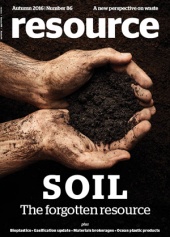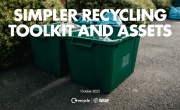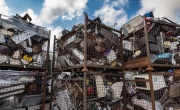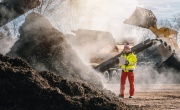Soil: The forgotten resource
A substance that can provide sustenance to maintain life on earth, that prevents flooding and desertification and that could even reverse climate change might sound impossible, but there's just so much material right under our feet. So why are we ignoring its health? Libby Peake discovers the virtues of soil
The Oxford English Dictionary’s primary definition of the word ‘resource’ is: ‘A stock or supply of money, materials, staff, and other assets that can be drawn on by a person or organisation in order to function effectively.’ Think of such assets in a circular economy context, and it’s most likely that what will spring to mind are things that can be taken from a set reserve of materials and used to make products in a sustainable way – whether they be raw materials like metals or oil, secondary materials, or indeed ‘waste’. But there’s one resource that clearly isn’t thought of enough, that is virtually taken for granted, and that’s soil. Scientists are now warning, though, that continuing to ignore it could have devastating consequences.
Explaining this resource blindspot rather bluntly (in 2012, but it could equally be said today), Professor John Crawford of the University of Sydney told Time magazine: “[S]oil isn’t sexy. People don’t always think about how it’s connected with so many other things: health, the environment, security, climate, water.”
Put simply, soil is more than just ‘dirt’, and is vital in many ways in addition to providing a place to grow the food that is needed to sustain life. Topsoil is full of microorganisms, holding more than a quarter of all biodiversity on earth, with Crawford explaining that “if you hold a handful of soil [like that pictured on the cover and following page], there will be more mircroorganisms in there than the number of people who have ever lived on the planet. These microbes recycle organic material, which underpins the cycle of life on earth, and also engineer the soil on a tiny level to make it more resilient and better at holding water.”
Unfortunately, degradation, which is now extremely widespread, drastically reduces soil’s ability to retain water, with Crawford noting: “Even moderately degraded soil will hold less than half of the water than healthy soil in the same location. If you’re irrigating a crop, you need water to stay in the soil close to the plant roots. However, a staggering paper was published recently indicating that nearly half of the sea level rise since 1960 is due to irrigation water flowing straight past the crops and washing out to sea.”
What’s more, because these microbes need carbon for food, soil is actually the second largest carbon reservoir on the planet – second only to the oceans – holding four times more carbon than all the world’s plants and trees. EU soils store nearly 50 times as much carbon as its member states emit as greenhouse gases every year. This means that improving the health of our soil could play a major part in preventing catastrophic climate change (more of which in a moment).
But first, what’s gone wrong?
For starters, it seems we didn’t learn the lessons of the Dust Bowl of 1930s, when extensive and deep plowing of the soil in the American Great Plains displaced native grasses that normally trapped the soil and moisture, leading to widespread drought and wind erosion (and to the dust storms that gave the period its name). Analogous modern farming practices have played a major part in pushing us towards a similar crisis today: the trend towards monoculture and continual tilling or ploughing of fields has seen much of the carbon in soil released into the atmosphere, meaning the microbes that make soil so useful have less to sustain them, which of course has a knock-on effect to the plants that grow in the soil. The modern tendency to remove crop stubble from fields – to use as animal feed, for instance – also damages soil because bare, exposed soil leads to the breakdown of soil structure, which also allows carbon to be released. And this is all compounded by heavy reliance on chemical fertilisers and pesticides, which kill soil’s biodiversity and, having done that, make the plants dependent on them, catching farmers in a vicious cycle where they are forced to pump more chemicals onto the land to keep it productive.
Again in Time magazine, Crawford added that the way the modern agricultural system has developed means farmers aren’t always incentivised to maintain the health of their soils, with so much of the attention given to increasing yield (much of which is currently wasted, of course!) instead: “Soil is not costed into food, which means that farmers don’t have the financial capacity to invest in their soil to turn the situation around. Crop breeding is exacerbating this situation. Modern wheat varieties, for example, have half the micronutrients of older strains, and it’s pretty much the same for fruit and vegetables. The focus has been on breeding high-yield crops that can survive on degraded soil, so it’s hardly surprising that 60 per cent of the world’s population is deficient in nutrients like iron. If it’s not in the soil, it’s not in our food.”
The consequences of these shortsighted policies are pretty drastic. Scientists from the University of Sheffield’s Grantham Centre for Sustainable Futures have gone so far as to describe the effect of soil degradation as ‘catastrophic’, following a 2015 study that calculated that nearly a third of the world’s adequate or high-quality food-producing land has been lost, and at a rate that far outstrips the natural processes to regenerate soil, which can take decades or even millennia – it takes roughly 500 years of unimpeded ecology to generate 2.5 centimetres of topsoil. The terrifying statistics don’t end there, either: an earlier University of Sheffield report warned that there are only 100 harvests left in our soil (or perhaps as few as 98 now, as that study was published in 2014), and, in addition to the third of food-producing land already gone to dust, scientists estimate that potentially more than half of agricultural land worldwide is moderately or severely affected by soil degradation, with more than a quarter of EU land affected by soil erosion due to water.
Even more worrying, perhaps, is that it’s not just cropland that is seeing its soil degrade. Roughly two- thirds of the world is suffering from desertification, with much of it occurring in the vast grasslands used for grazing around the world. The assumption held for decades by the vast majority of scientists and conservationists was that desertification is caused by overgrazing of livestock – predominantly cattle, sheep and goats – as intensive grazing leaves the soil bare. However, ecologist Allan Savory says this assumption is as false as the long-held belief that the earth was flat.
Giving a TED talk in 2013, he said he realised this when he observed that desertification is a major problem in American national parks, where there has been no grazing for 70 years. “What we had failed to understand”, he claims, “was that [in] these seasonal humidity environments of the world, the soil and the vegetation developed with very large numbers of grazing animals, and that these grazing animals developed with ferocious pack-hunting predators. Now, the main defense against pack-hunting predators is to get into herds, and the larger the herd, the safer the individuals. Now, large herds dung and urinate all over their own food, and they have to keep moving, and it was that movement that prevented the overgrazing of plants, while the periodic trampling ensured good cover of the soil.”

So, the answer to desertification and to the linked problem of climate change, Savory says, is that (in addition to ending the common practice of burning soil, which leaves soil bare, while releasing carbon and damaging pollutants) is to “do the unthinkable, and to use livestock, bunched and moving, as a proxy for former herds and predators, and mimic nature. There is no other alternative left to mankind.” He admits that it is extremely complex, but says that “holistic management and planned grazing”, in which herders bunch their animals and “mimic nature” by moving them every few days to encourage optimal grass growth, can “address all of nature’s complexity and our social, environmental, economic complexity” – increasing vegetation cover, stopping desertification and, crucially, reversing climate change.
Away from the grasslands, back at the arable farmlands, scientists say there are solutions there, too, but they’re solutions that must be implemented immediately to avoid irreparable damage to the soil and the planet’s climate, which the soil protects with such little recognition.
Increasingly, experts are calling for a move away from industrial agriculture to a more holistic approach that recognises the interdependence of living systems and restores soil through measures including treating land with compost, organic fertiliser or even human sewerage, crop rotation, limited tilling (or no tilling whatsoever, where possible), and using cover crops (such as temporary crops planted between the main cash crops) or retaining crop residues to avoid bare land, while also discouraging erosion and helping retain carbon. Scientists agree that such a move, known as ‘regenerative farming’, will lead to more carbon sequestration, though estimates vary as to what extent. According to one recent white paper on regenerative organic agriculture from the Rodale Institute, though, implementing these practices around the world would not only ‘comfortably feed the growing human population’, it would also repair damaged ecosystems and could potentially sequester more than 100 per cent of current annual carbon emissions.
Such a move would, of course, require bold policymaking and a willingness to take on the likes of Monsanto, Syngenta and others that dominate industrial agriculture (which I would suggest ought to be referred to as ‘big agro’ from now on), but scientists and regular citizens alike are increasingly recognising the need to do so, and calling on governments to join them. Duncan Cameron, Professor of Plant and Soil Biology at the University of Sheffield, told the Guardian ahead of last year’s climate talks in Paris: “We need a radical solution, which is to re-engineer our agricultural system. We need to take land out of production for a long time to allow soil carbon to rebuild and become stable. We already have lots of land – it’s being used for pasture by the meat and dairy industries. Rather than keep it separated, we need to bring it into rotation, so that that there is more land in the system and less is being used at any one time.
“We can’t blame the farmers in this. We need to provide the capitalisation to help them rather than say, ‘Here’s a new policy, go and do it.’ We have the technology. We just need the political will to give us a fighting chance of solving this problem.”
 This article was taken from Issue 86
This article was taken from Issue 86More recently, an umbrella organisation of more than 300 civil organisations from throughout the European Union (EU), People4Soil, has been echoing this call by launching a European Citizens’ Initiative demanding that the EU recognise soil as ‘a shared heritage that needs EU-level protection’ and to close the ‘legal gap’ that means that there is currently no law ensuring its conservation for future generations.
The group is calling for a specific legal framework to protect soil, which it says should feature (amongst other measures) an ‘acknowledgment of ecosystem services provided by soil and the recognition of its importance for biodiversity conservation and food security’, as well as ‘the deployment of policies committed to reverse the declining trend in soil organic matter and to reduce inputs by synthetic fertilisers and pesticides’.
If we get this right, there’s no reason why every generation to come shouldn’t benefit from the resource of healthy soil and the advantages it brings. Interestingly, the word ‘resource’ originates from the Old French dialect resourdre, meaning to rise again (based on Latin surgere, ‘to rise’) and so, perhaps, soil, rather than being forgotten should be viewed as the archetypal resource. It’s not something that can be stockpiled in a finite supply and used for our own ends, but it is a substance that we can work with again and again, that rejuvenates with incredibly advantageous consequences, allowing ecosystems and, with them, human life to continue thriving long into the future. 







